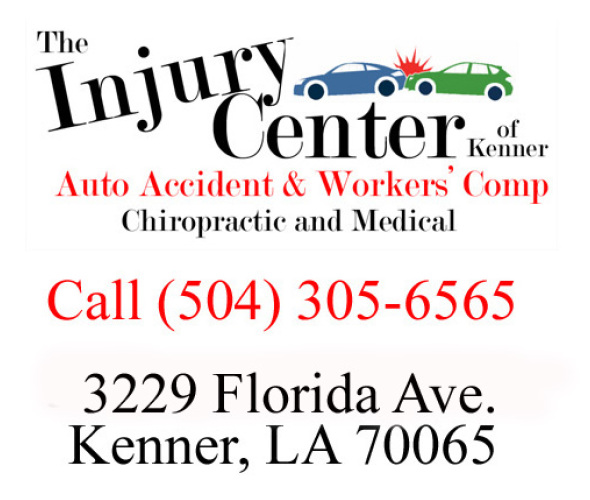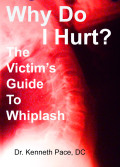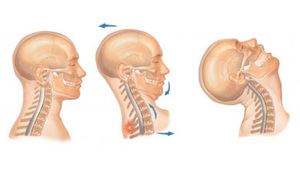Whiplash/Car Wreck Treatment (AKA Whiplash Associated Disorder [WAD], Cervical Accelleration/Decelleration Injury [CAD])
The following information is taken from Dr. Pace's whiplash book.
If you’ve been injured in a car wreck you’ve got several options for treatment.
The types of practitioners who commonly treat whiplash include chiropractic doctors, medical doctors, osteopathic doctors, physical therapists, occupational therapists, acupuncturists and massage
therapists.
Each of these professions help people with a variety of health complaints, but the question to be answered is this: which has been proven by scientific research to be the best treatment for whiplash
injuries.
And for this question there is only one answer: Chiropractic.
Chiropractic doctors are primary care health care providers licensed by each of the 50 United States and by the governments of many other nations (including Canada) to diagnose and treat conditions
of the human body without the use of drugs or surgery. The primary method of treatment provided by chiropractors is known as spinal manipulation. The primary goal of spinal manipulation
treatment is to restore the position and function of the joints of the spine.
The primary cause of neck and back pain from whiplash is restricted motion in the spinal joints. In the process of the whiplash injury, shear effect to the spine causes minor changes in the
position of joints in the spine, as well as major changes in the function of the joints of the spine, resulting in restricted motion of the joints, which causes pain, as well as the other
symptoms.
While drugs may provide temporary relief of pain (until the effect of the drug wears off), they do nothing to correct the damage that the whiplash caused. And while the other treatments mentioned do have merit for a variety of ailments, none have been shown to provide any long-term benefit for whiplash injury.
A study reported in the Journal of Orthopaedic Medicine summarized it this way:
"Conclusion: Whiplash injuries are common. Chiropractic is the only proven effective treatment in chronic cases.”
This study was conducted by a team of medical researchers at the University Department of Orthopaedic Surgery in Bristol, England. The objective of the study was to determine which patients
with chronic whiplash benefit from chiropractic treatment. The study consisted of two groups of patients. Group 1 consisted of patients with isolated neck pain and restricted range of
neck movement. Group 2 consisted of patients with neurological symptoms or signs and restricted range of movement.
In both groups, chiropractic was the only method of treatment that was proven effective. (1)
This study followed another study from the same university that showed that although 43% of whiplash victims suffer long-term symptoms for which no conventional (medical) treatment has proven to be
effective, 93% of patients im-proved following chiropractic treatment. (1)
Another study compared the effects of chiropractic treatment to the drugs Vioxx and Celebrex, and acupuncture in the treatment of chronic spine pain, and followed up a year later. An earlier
study showed that after 9 weeks of treatment, chiropractic spinal adjusting was more than 5 times more effective than the drugs Celebrex or Vioxx. Follow up after a year showed that the
therapeutic benefit of chiropractic spinal manipulation was largely stable for at least a year, much better than either drugs or needle acupuncture. (2)
The authors of this study also stated that in cases of mechanical spine pain (such as whiplash) only about 15% of patients are given a definitive diagnosis. What this means to you is if you’ve been in an accident and have spinal pain, and have been to a doctor other than a chiropractor, there’s an 85% chance that you’ve been misdiagnosed, and as such, you probably haven’t received proper treatment.
What If I Don’t Get Treated Properly?
Since 1956 more than 55 studies have followed the long-term effects of whiplash injury. (6,7)
According to this huge volume of work, only about 35 to 50% of whiplash victims ever fully recover, leaving between 50 to 65% who never recover completely. (6)
For example, one study found that 43% of patients will suffer long term symptoms following whiplash injury, for which no conventional treatment has proven to be effective. (8)
Why? Perhaps it’s because those unfortunate people have either been diagnosed or treated improperly.
Another study found that 85% of patients in car wrecks are given a wrong diagnosis, meaning that about 85% receive improper treatment. That easily explains why such a huge number never fully recover from their whiplash injuries.
In the same study that showed that 43% of whiplash victims suffer long-term symptoms, they also found that 93% of patients improved following chiropractic treatment. (8)
So what happens if you don’t get proper treatment from a chiropractic doctor? Will your injuries heal without treatment? It’s possible that any given whiplash injury could completely
resolve itself over time without any treatment whatsoever.
Possible, but not probable.
Since it’s impossible to tell whether your injuries will heal themselves, the prudent thing to do is again look at the available research to see what happens to most people who get improper treatment
or no treatment at all.
An English study followed 3047 hospitalized acute trauma patients ages 18 to 84, 12 months after injury. At 12 months after injury, 62.7% of these individuals still had pain from their injury,
and most had pain in more than one area of the body. Zero to 10 pain scales averaged a pain level of 5.5 at follow up.
The author’s conclusions: “Most trauma patients have moderately severe pain from their injuries 1 year later.” (9)
Another study found a relationship between a history of neck injury in car wrecks and moderate to severe headaches. The authors stated “Our cross sectional analysis suggests that neck pain and
severe headaches are more prevalent in individuals with a history of neck injury from a car collision.” (10)
Additionally, this study showed that neck pain and headaches are not the only long-term pains from whiplash. The study also looked at other conditions that may be related to a history of neck injury
from whiplash. The authors looked at allergies, breathing, cardiovascular, and digestive disorders, hypertension and low back pain. They found that people who had previous whiplash
injuries had a greater chance of suffering from all of the above disorders, except hypertension. The instance of many of these disorders was close to twice as frequent as those with no history of
neck injury. Plus, people who had suffered neck injuries and who suffered from one of these disorders reported that the impact of the disorder was greater than was reported by those without neck
injury. Additionally, they found that the general health of those having been injured was significantly lower than in those who had not. (10)
In another study, researchers applied a device to the spine of small animals for varying lengths of time then removed them. Analysis of these animals after the devices were removed showed
arthritic changes in the area of fixation (fixation can be defined as an area that has lost it’s normal range of motion). This probably indicates that if an area is restricted from normal
motion for even a short amount of time, arthritis (degeneration) is sure to follow. (11)
If it’s true that restricted motion causes arthritis, then doesn’t it make sense that restoring the normal motion following injury would help stop or slow down these degenerative changes?
This is another reason that chiropractic treatment has been proven to be so effective in whiplash treatment. Spinal manipulative treatment corrects fixations of spinal and other joints that is
brought on by the shearing forces of the whiplash injury by restoring the normal motion that is required for normal function. And normal function generally equals no pain.
References
1. Kahn, S. Cook, J. Gargan, M. Bannister, G. (A symptomatic classification of whiplash injury and the implications of treatment). Journal of Orthopaedic Medicine, Volume 21 (1999): pages 22-25.
2. Reinhold, M. Giles, GFL. (Long-term follow-up of randomized clinical trial assessing the efficacy of medication, acupuncture, and spinal manipulation for chronic mechanical pain syndromes). Journal of Manipulative and Physiological Therapeutics. Volume 28, Num-ber 1 (2005).
3. Calliet, Rene. Whiplash Associated Diseases. Chicago, IL: American Medical Association, 2006. (page 87)
4. Calliet, Rene. Whiplash Associated Diseases. Chicago, IL: American Medical Association, 2006. (page 96)
5. Foreman, S and Croft, A. Whiplash Injuries The Cervical Accelera-tion/Deceleration Syndrome, Third Edition. Lippincott, Williams & Wilkins, 2002. (page 501-510)
6. Foreman, S and Croft, A. Whiplash Injuries The Cervical Accelera-tion/Deceleration Syndrome, Third Edition. Lippincott, Williams & Wilkins, 2002. (page 410)
7. Croft, A. (Can you guage injury risk or severity from the amount of vehicular property damage in motor vehicle crashes?) Dynamic Chi-ropractic. Volume 20, Issue 26 (December 16, 2002).
8. Woodward, MN. Cook, JC. Gargan, MF. Bannister, GC. (Chiro-practic treatment of chronic whiplash injuries). Injury. 27(9) (1996): pages 643-645.
9. Rivara, F. MacKenzie, E. Jurkovich, G. Nathens, A. Wang, J. Scharfstein, D. (Prevalence of pain in patients 1 year after major trauma). Archives of Surgery. 143(3) (2008): pages 282-287.
10. Croft, A. (Long term consequences of whiplash: Allergy; Breathing, Digestive and Cardiovascular Disorders; Hypertension and Low Back Pain). Dynamic Chiropractic. Volume 18, Issue 22 (October 16, 2000).
11. King, M. (Neck pain and whiplash associated disorder [WAD]). Dynamic Chiropractic. Volume 25, Issue 11 (May 21, 2007).
|
Different Doctors and Different Approaches to
Care
|
||||||||||||||||||||||||||||||||
|
Whiplash injuries are a significant public health problem. Not only do they cause significant pain and time off from work and leisure activities, there is also a general effect on quality of life. A study in the European Spine Journal compared female patients with whiplash of the neck to patients with low back pain and another group with rheumatoid arthritis. The researchers looked at pain levels (how high or low) and how quality of life was affected. In the whiplash group, the pain levels were the highest. Overall health status was also more affected in the whiplash group, with changes mostly in social issues, vitality, emotional, and mental wellbeing.
A study in the journal Spine looked at how medical and chiropractic doctors differed in their approach to patients with whiplash. Medical doctors were more likely to have negative feelings about treating patients who have whiplash. They were also more likely to believe that there was nothing physically wrong with many patients with chronic whiplash. In terms of treatment, most medical doctors believed that nonsteroidal anti-inflammatory drugs (NSAIDs) and muscle relaxants were effective in acute whiplash.
This is despite the significant scientific evidence of problems of safety with long -term consumption of NSAIDs (e.g. stomach bleeding). In addition to questions of safety, there is virtually no evidence that these types of medications actually improve patients' pain or overall quality of life.
The chiropractic approach to whiplash is much different from that of medical doctors. First there is a general acceptance that the injuries are real and are not made-up by the patient. Biomechanical study of auto accidents confirms the injuries are real and mostly consist of sprain and subluxation of the joints of the neck. The spinal ligaments, muscles and disks are all affected in whiplash injury. When trauma to these tissues occurs, the sensitive nerves that go between these structures are also irritated, resulting in pain and changes in balance (e.g. dizziness, and position sense). Over time, the patient may have significant effects on their quality of life.
One study of chiropractic care in the journal Injury looked at the results in patients with chronic (i.e., long-term) whiplash injuries-which occurs in about 43% of cases. Twenty-eight patients were studied and of these 93% (n=26) had improved following chiropractic treatment. There are important differences in your treatment when you compare the chiropractic to the medical approach to whiplash.
|




